Kost-Bet puts additional concrete block making machine into operation
16 mars 2011 - In summer 2009, Masa AG received an order from the Kost-Bet company to deliver a complete block making machine to Alexandria (Konopiska) in Poland. This plant is already Kost-Bet's second Masa plant.
The company, which was established in 1998, has developed within the last few years into one of the largest suppliers of decorative paving and garden construction products in the south of Poland. In the course of a further expansion, the company intends to gain further market shares in future. The main products are paving stones of all kinds in different colours, multicolour stones, brims and kerbstones and other garden construction products, all of which meet very high quality requirements.
Due to positive experiences with Masa AG with the first block making machine, it was an easy decision for Kost-Bet to purchase another Masa plant of the type XL 9.1. Kost-Bet was convinced by the high machine quality and Masa's good service, as well as the high availability of the plant. The mode of function of this modern concrete block making machine is briefly described below.
Mixing and dosing plant
The material is supplied to the dosing plant from a total of 5 delivery silos. The various raw materials are weighed and afterwards filled directly into the mixer elevators. Further components such as cement and other additives are fed to the mixer via screw conveyors.
The quadruple dye dosing unit doses the liquid dye into the mixer according to the recipe. Special scales are used for weighing liquid additives. Both the dyes and the additives as well as the corresponding dosing equipment were supplied entirely by the Remei company.
The Masa PH 1500/2250 and S 350/500 high performance mixers produce high concrete quality for all quality classes with short mixing times. A particularly homogeneous mixing effect is achieved by compulsory mixing using the countercurrent principle with mixing tool movement at several levels. These practically proven plants excel because of their energy efficiency and low maintenance requirements.
Water dosing is completely automatic. A virtually unlimited number of mixture recipes can be developed and stored. After mixing, the concrete is transported by a bucket track system to the concrete silos of the block making machine.
Block making machine
As in 2006 this new works had to fulfil the following conditions:
- The manufactured products meet the high quality requirements
- Paving stones can be produced in various forms and colours.
- All products for garden and landscaping, especially paving and kerbstones can be produced.
As with the first block making machine, the Masa XL 9.1 S block-making machine (S = fast version) was selected with a board size of 1400 mm x 1100 mm. Kost-Bet decided to produce on steel underlay boards with a thickness of 14 mm.
The type XL 9.1 block making machine is a stationary, fully automatic universal block making machine for the mass production of concrete blocks from lightweight and heavy concrete and is the top model in Masa AG's range of block making machines. The machine is comprised of a three-part machine frame: the central part with vibrating table, and the core concrete and facing concrete filling stations. These filling sections can be opened separately, so that the machine is much more accessible for cleaning and maintenance.
Technical characteristics of the XL 9.1:
- Machine is of a particularly heavy, stable design (Total weight over 40 t)
- Extra-long guide bearing on the tamper and mould.
- Fully automatic mould change (< 10 minutes) including automatic vertical adjustment of core and facing filling sections
- Manufacturing of building blocks, retaining wall elements and dry wall stones with precise heights.
- The machine functions are carried out by means of highly-dynamic, maintenance-free proportional valves with integrated electronics.
- Machine control is carried out on a decentralised basis by means of Profibus.
- S-package (fast): higher pump output, additional hydraulic accumulator, V-belt conveyor with integrated lowering device, laser measurement of core and facing concrete level
Instead of the usual stepless rpm control of the vibration table the machine is fitted with a amplitude controlled vibration system (Servo-Vibration), which allows for stepless matching of the actual compression forces to the needs specified by the product. Different forces can be generated in the case of pre, intermediate and main vibration, an amplitude change can even be made during production.
The rugged and simple design of the vibration system guarantees their long lifetime. The inevitable noise emissions in the vicinity of the block making machine are reduced by the hydrautainer concept. For this purpose, the machine hydraulics are integrated into a specially adapted 40' sea container. Depending on other measures, a considerable reduction in noise emissions can be achieved here. Masa AG is catering to the ever increasing trend towards noise reducing measures with this series standard concept.
Product handling
The concrete blocks produced by the machine are transported to the lifting rack by means of a lowering device and a lift and carry conveyor. The concrete blocks are placed into the shelving installation for curing by a fully automatic transfer table (22 levels, level spacing: 320 mm) in a rotatable version. The shelving installation was realised on-site in the form of a closed system with recirculating air equipment. This ensures optimised drying with a minimum expenditure of energy.
After the drying process the blocks are taken out of the shelving to the dry side. For this purpose, the transfer table transports the dried blocks to a descending rack. From here, the layers of blocks are transported back to the packeting system, where the blocks are automatically assembled into packets. Return transport is by a lift and carry conveyor. The drive is in each case provided by a geared servo-motor.
The basic structure of the packeting device consists of a portal frame of robust profile steel. The warp-resistant chassis as well as the lifting and lowering movement are each driven by toothed belts and geared servo-motors. The 360° rotatable gripping and clamping device takes the form of an electrically driven four-sided clamp (servo-clamp).
After packeting, the packets are strapped horizontally and vertically. The packaged products are transported by a slat conveyor to the outdoor area. They are then taken by fork-lift truck to the storage yard. Masa AG has very recently changed its plants in particularfrom hydaulic to servo-drive technology. The plants are thus more environmentally friendly than conventional hydraulic plants, since the use of hydraulic oils and the associated environmental impacts can be dispensed with for the most part. In an international comparison, Masa AG is placing a considerably higher emphasis on environmental friendliness with this solution than other manufacturers of block making machines.
Control and operation
The plant is controlled by a controller developed by Masa on the basis of the S7, with PC and touch-screen monitor. As is usual for Masa, the control cabinets of all controllers are pre-installed in a 'powertainer', a specially adapted 40" sea container. This is advantageous in that the installation of the plant is accelerated and the control cabinets are housed protectively in a acclimatised room.
Profibus systems network the decentralised S7 plant controller. Functions can be selected and data input directly using the colour display touch screen. The visualisation software supplied has simple graphical function displays, a user guide and unlimited recipe management. The built-in statistics program records all operating data, which can be transferred to external PCs.
Kost-Bet is the first Polish company to benefit from yet another innovative concept from Masa AG. Instead of the otherwise usual cable conduits that have to be installed by the customer in the foundation slab, in which the electrical power cables are then laid, Masa installed cable trays with this plant. The laying of the cables thus no longer causes any extra expenditure for Kost-Bet. Besides that, the cables are much easier to access and to exchange if necessary.
Conclusions
Kost-Bet will in future continue successfully along the road they have chosen with a versatile range of high quality products. This is guaranteed by the plants supplied by Masa, which are designed and built taking into account the latest technical aspects and demands placed on a concrete plant. Kost-Bet thus has one of the most modern and effective block making machines in Poland at its disposal.

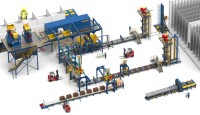 Un long chemin mène des matières premières au mélange jusqu' au bloc fini. De nombreux composants de l'installation sont impliqués dans ce processus. Seule une adaptation parfaite des différents composants de l'installation permet de garantir le bon déroulement du processus et un fonctionnement économique de l'installation de production de blocs de béton.
Un long chemin mène des matières premières au mélange jusqu' au bloc fini. De nombreux composants de l'installation sont impliqués dans ce processus. Seule une adaptation parfaite des différents composants de l'installation permet de garantir le bon déroulement du processus et un fonctionnement économique de l'installation de production de blocs de béton.
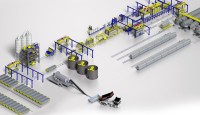 La production du béton cellulaire impose des exigences élevées en ce qui concerne la préparation et le dosage des matières premières, la surveillance du processus de levée et la commande de toutes les opérations de fabrication. Les installations de fabrication du béton cellulaire Masa sont techniquement éprouvées et conçues en fonction des exigences individuelles de nos clients. Il en résulte des solutions complètes, qui garantissent une rentabilité élevée, des processus optimisés et une qualité constante des produits finis.
La production du béton cellulaire impose des exigences élevées en ce qui concerne la préparation et le dosage des matières premières, la surveillance du processus de levée et la commande de toutes les opérations de fabrication. Les installations de fabrication du béton cellulaire Masa sont techniquement éprouvées et conçues en fonction des exigences individuelles de nos clients. Il en résulte des solutions complètes, qui garantissent une rentabilité élevée, des processus optimisés et une qualité constante des produits finis.
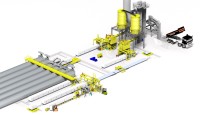 Un long chemin mène des matières premières au mélange jusqu' aux blocs finis. De nombreux composants de l'installation sont impliqués dans ce processus. Seule une adaptation parfaite des différents composants de l'installation permet de garantir le bon déroulement du processus et un fonctionnement économique de l'installation de production de blocs silico-calcaires.
Un long chemin mène des matières premières au mélange jusqu' aux blocs finis. De nombreux composants de l'installation sont impliqués dans ce processus. Seule une adaptation parfaite des différents composants de l'installation permet de garantir le bon déroulement du processus et un fonctionnement économique de l'installation de production de blocs silico-calcaires.
 Un long chemin mène des matières premières au mélange jusqu' aux bordures finies. Les presses pour la fabrication des bordures Masa on été développées entre autres pour satisfaire aux exigences spéciales des bordures selon le "British Standard". Ce "British Standard" est encore en vigueur dans les pays du Moyen-Orient et en Grande-Bretagne par exemple.
Un long chemin mène des matières premières au mélange jusqu' aux bordures finies. Les presses pour la fabrication des bordures Masa on été développées entre autres pour satisfaire aux exigences spéciales des bordures selon le "British Standard". Ce "British Standard" est encore en vigueur dans les pays du Moyen-Orient et en Grande-Bretagne par exemple.
 Les installations et les machines Masa sont installées et mises en service par nos monteurs expérimentés. À cet effet, Masa emploie du personnel spécialisé et formé en Allemagne.
Les installations et les machines Masa sont installées et mises en service par nos monteurs expérimentés. À cet effet, Masa emploie du personnel spécialisé et formé en Allemagne.
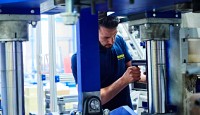 Le service Lifetime Masa va bien au-delà du montage et de la mise en service d'une installation. Masa peut se prévaloir d'un savoir-faire spécifique et d'une expérience dans le secteur de plus de 110 ans.
Le service Lifetime Masa va bien au-delà du montage et de la mise en service d'une installation. Masa peut se prévaloir d'un savoir-faire spécifique et d'une expérience dans le secteur de plus de 110 ans.
 Vous avez besoin d'assistance pour votre machine ? L'Assistance Masa met l'accent aussi bien sur la qualité que sur une disponibilité considérablement améliorée. Qu'il s'agisse de vous apporter les "premiers secours" en cas de problèmes techniques, de mises à jour, d'une extension des fonctions de votre installation de production, ou de répondre à des questions techniques, le savoir-faire mis à votre disposition dans le cadre de l'Assistance Masa couvre un large éventail de prestations.
Vous avez besoin d'assistance pour votre machine ? L'Assistance Masa met l'accent aussi bien sur la qualité que sur une disponibilité considérablement améliorée. Qu'il s'agisse de vous apporter les "premiers secours" en cas de problèmes techniques, de mises à jour, d'une extension des fonctions de votre installation de production, ou de répondre à des questions techniques, le savoir-faire mis à votre disposition dans le cadre de l'Assistance Masa couvre un large éventail de prestations.
 L'une des clés essentielles pour augmenter la productivité et la qualité est la qualification continue du personnel opérateur et de maintenance.
Le savoir-faire acquis sera rapidement payant : En effet, vous ne pouvez apprécier à quel point une machine ou une installation Masa est efficace que si vous et vos collègues connaissez toutes les astuces et les préréglages de précision.
L'une des clés essentielles pour augmenter la productivité et la qualité est la qualification continue du personnel opérateur et de maintenance.
Le savoir-faire acquis sera rapidement payant : En effet, vous ne pouvez apprécier à quel point une machine ou une installation Masa est efficace que si vous et vos collègues connaissez toutes les astuces et les préréglages de précision.
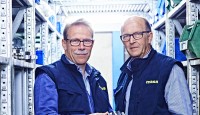 Vous cherchez un interlocuteur ? L'équipe Service client Masa se présente.
Vous cherchez un interlocuteur ? L'équipe Service client Masa se présente.
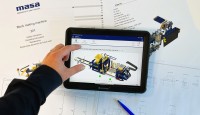 Masa Service Cloud est le dernier né de la famille des produits digitaux.
Masa Service Cloud est le dernier né de la famille des produits digitaux.